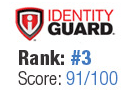Learn How to Detect Identity Theft
Identity theft is becoming increasingly more common. In 2008 identity theft crimes increase by 22% over the previous year. Learning how to detect identity theft is very important in protecting your identity. Identity thieves are becoming more and more advanced in their theft techniques thus understanding and implementing detection techniques is essential to safeguarding your identity. We have compiled resources, articles as well as review the different identity theft protection services to help you better detect and prevent identity theft.
IdentityGuard.com – Top Detection Pick
IDENTITY GUARD® Review
 Overall, IDENTITY GUARD®’s protection is very thorough, providing protection from nearly every angle, and offering customers tons of options.
Overall, IDENTITY GUARD®’s protection is very thorough, providing protection from nearly every angle, and offering customers tons of options.
Do It Yourself Identity Theft Detection
Identity theft detection is vital to protect and maintain your good name. Although identity theft protection services will help detect signs of identity theft, there are many things an individual can do on their own to detect identity theft. We have provided all the information needed for you to monitor and detect signs of identity theft and to protect your good name.
Learn The Signs Of Identity Theft
Because identity theft is one of the leading crimes in the United States, individuals can never be too conscientious when it comes to detecting and avoiding it. Read More »
Credit Monitoring
Credit monitoring is the tracking of individuals’ credit histories for any suspicious activity or changes. Credit monitoring helps individuals to detect credit-related fraud and identity theft. Read More »
AnnualCreditReport.com | Fact Act
The Federal Fact Act of September 1, 2005, requires TransUnion, Experian, and Equifax to issue a free credit score to every consumer once per year. Read More »
Learning About Credit Scores
Credit scores are a great way for consumers to help protect against identity theft because they are able to view any suspicious changes made to their accounts. Read More »
